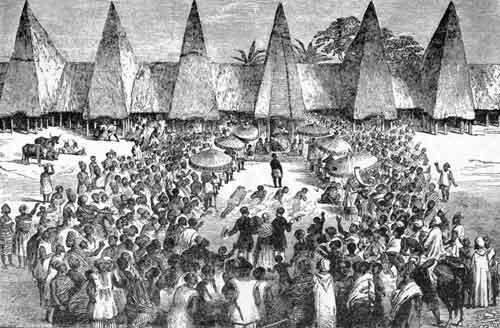Yoruba Art and its battle of methodologies
Yoruba Art and its battle of methodologies
The focus of Blier’s book is on works she categorizes under Florescence and Post-Florescence eras. She ties the Florescence era to Obalufon II, an Ife king noted in Yoruba tradition as a major art patron and who Blier describes as the king and art patron that encouraged the marriage of old and new Ife, the period before and after the ‘emergence’ of Oduduwa. Drawing connections between Ife rituals such as Oramfe and Olojo in particular, Blier identifies the preoccupation of ancient Ife sculptures with the theme of conflict, change of political order, and reconciliation of both losers and winners of the struggles for power over the kingdom. By relating the works of other cultures: Ugbo-Ukwu, Tada, Benin, and Igala, for example, Blier suggests that ancient Ife was undoubtedly a cosmopolitan center for a large section of precolonial West Africa. Similarities in artistic motifs and style, she affirms, must have affected the creative industry in a city-state that was in its own time a melting pot for several nationalities and their cultures. The suggestion that the art of ancient Ife was enriched by contact with neighboring cultures should not surprise observers of influence of other cultures on the Lagos of today.
Without doubt, readers will find these two books insightful for different reasons. Both of the books cover a wide range of visual objects, ranging from memorialization of monarchs to depiction of animals. In an ancient society that was characterized by animism, it is not surprising that totem of power, such as leopard, elephant, horse; totem of peace such aseja-aro (a sub-specie of cat-fish) and snail; as well as totem of alterability or change such asagemoor oga(chameleon) featured prominently in the samples examined by both Blier and Abiodun. Similarly, the Yoruba habit of elaborate dressing that includes layers of clothing and adornment of dress with elaborate embroidery acknowledged byAbiodun andBlier in ancient Ife art is also a major part of Yoruba fashion today.
On the surface, especially with reference to the introduction to both books, readers are likely to find the messages of the two books to be counter-signs, but the body of each of the two books makes the authors’ analyses act more like co-signs than counter-signs. Both books have substantial significance to the study of Yoruba culture, especially its aesthetics and iconography. Abiodun in his book combines old and new Yorubaaesthetic concepts and vocabularies to make Yoruba visual art—naturalist, stylized, and idealized—intelligible to both specialists and people with interest in understanding the relationship between Yoruba thought system and artistic production. He provides new analytical techniques that can provide models for art and culture scholars not only in the Yoruba world but also in sub-Saharan Africa, as well as forthose in other parts of the world who need knowledge of indigenous perspectives to enrich their understanding of African visual culture.Abiodun popularizes an area of study of African cultural production that has been kept on the back burner for long; development of emic or indigenous perspectives and concepts that explain nuances (and sometimes the so-called mystery) of visual art in Africa produced by artists who practiced largely in the era before their contact with Westernepistemology and hermeneutics.Abiodun does effectively with Yoruba art what Western art scholars do with theirs: art interpretation in relation to Western worldview: philosophy, ethics, metaphysics, values, and language. His work is in good stead to motivate others working in the field of African art and criticism.
Blier in her own book provides additional methods of reading ancient Ife art in a way that can be intelligible to the Anglophone world, which also includes Africans in diaspora and professional art critics on the African continent.She provides insights on the desire of ancient Ife artists to tell stories about the evolution of the kingdom by applying a multidisciplinary analysis to numerous samples of Ife visual art. While recognizing the politics of ancient Ife art, Blier provides insight on the connection between Ife art and desire of its ancient leaders to overcome the division that periodic struggles for power created or could create. She also uses her methodology to suggest a clue to issues that may puzzle the Yoruba world; the role of multiculturalism in ancient Ife and its influence on the flowering of sculpture in the ancient kingdom.
Each of these two books deserves whatever investment goes into its purchase. The books complement each other in many ways and will be of immense benefit to art and culture scholars who want to deepen their knowledge of an ancient artistic tradition that continues to exciteart connoisseurs worldwide. Students of Yoruba art should read Abiodun’s book before reading Blier’s, as doing so will enhance appreciation of Blier’s book. In addition, it will be a profitable investment in knowledge and culture, if Obafemi Awolowo University in Ile-Ife, in collaboration with other knowledge centers,guardians of Yoruba culture such as: Ooni, Alaafin, Awujale, Olowo,Osemawe, Orangun, Ewi, etc., and rich collectors of Yoruba art such as OmoobaShyllon,can organize an international colloquium at Ife, to discuss the two books that seek to change for different reasons the study of Yoruba art.
by Ropo Sekoni For The Nation Online
Be the first to post a message!
